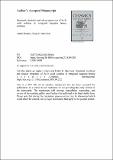Files in this item
Structural, electrical and relaxor properties of Sc-In solid solution in tetragonal tungsten bronze ceramics
Item metadata
| dc.contributor.author | Rotaru, Andrei | |
| dc.contributor.author | Morrison, Finlay D. | |
| dc.date.accessioned | 2019-09-19T23:37:32Z | |
| dc.date.available | 2019-09-19T23:37:32Z | |
| dc.date.issued | 2019-02-01 | |
| dc.identifier | 255998132 | |
| dc.identifier | f6a60bab-345f-4e27-9ddb-ec89ac33d93f | |
| dc.identifier | 85054144948 | |
| dc.identifier | 000453491400003 | |
| dc.identifier.citation | Rotaru , A & Morrison , F D 2019 , ' Structural, electrical and relaxor properties of Sc-In solid solution in tetragonal tungsten bronze ceramics ' , Ceramics International , vol. 45 , no. 2, Part B , pp. 2710-2718 . https://doi.org/10.1016/j.ceramint.2018.09.202 | en |
| dc.identifier.issn | 0272-8842 | |
| dc.identifier.other | RIS: urn:026B44A8C2B675E73E0121FC70EF9576 | |
| dc.identifier.other | ORCID: /0000-0002-2813-3142/work/48774787 | |
| dc.identifier.uri | https://hdl.handle.net/10023/18522 | |
| dc.description | The authors would like to thank to the following funding organisations: the Royal Society for providing a research fellowship (F.D.M.), EPSRC for providing the PhD student grant (A.R.) and Roberto Rocca Education Program for providing an additional fellowship grant (A.R.). | en |
| dc.description.abstract | The electrical properties of a family of tetragonal tungsten bronze (TTB) materials, Ba6Sc1-xInxNb9O30 (x = 0.25, 0.5, 0.75), which display relaxor properties were characterised using high-temperature impedance spectroscopy and low-temperature dielectric spectroscopy. All powders were synthesized at 1250°C (24hours) + 1350°C (6.5hours), while the pellets were further sintered at 1350°C (12hours). At high temperature, the electrical conductivity in all samples is dominated by a single response, attributed to the bulk response, while the subtle asymmetry of the imaginary impedance peak suggests a minor contribution of the grain boundary response. In general, the Sc-In solid solutions samples exhibit similar electrical behaviour to the Sc compound, x = 1 reported previously (Ceram. Int. 2016, 42, 11810–11821). At low temperature all compounds exhibit frequency dependent relaxor behaviour. With increasing the content of In, the dielectric peaks are more asymmetric and the curves flatten more at temperatures above the transition temperature. The dipole freezing temperature, TVF, determined by Vogel-Fulcher (VF) analysis does not simply increases linearly as a function of M3+ (Sc3+,In3+) cation size, the extrapolation of VF-like curves results in considerably different values when compared to those found previously, since the acquired dielectric data are very sensitive to preparative conditions. | |
| dc.format.extent | 9 | |
| dc.format.extent | 1450260 | |
| dc.language.iso | eng | |
| dc.relation.ispartof | Ceramics International | en |
| dc.subject | Electrical conduction | en |
| dc.subject | Microstructure | en |
| dc.subject | Relaxor behaviour | en |
| dc.subject | Tetragonal tungsten bronzes | en |
| dc.subject | Vogel-Fulcher analysis | en |
| dc.subject | QD Chemistry | en |
| dc.subject | NDAS | en |
| dc.subject.lcc | QD | en |
| dc.title | Structural, electrical and relaxor properties of Sc-In solid solution in tetragonal tungsten bronze ceramics | en |
| dc.type | Journal article | en |
| dc.contributor.sponsor | The Royal Society | en |
| dc.contributor.institution | University of St Andrews. School of Chemistry | en |
| dc.contributor.institution | University of St Andrews. EaSTCHEM | en |
| dc.identifier.doi | 10.1016/j.ceramint.2018.09.202 | |
| dc.description.status | Peer reviewed | en |
| dc.date.embargoedUntil | 2019-09-20 | |
| dc.identifier.grantnumber | UF041268 | en |
This item appears in the following Collection(s)
Items in the St Andrews Research Repository are protected by copyright, with all rights reserved, unless otherwise indicated.

